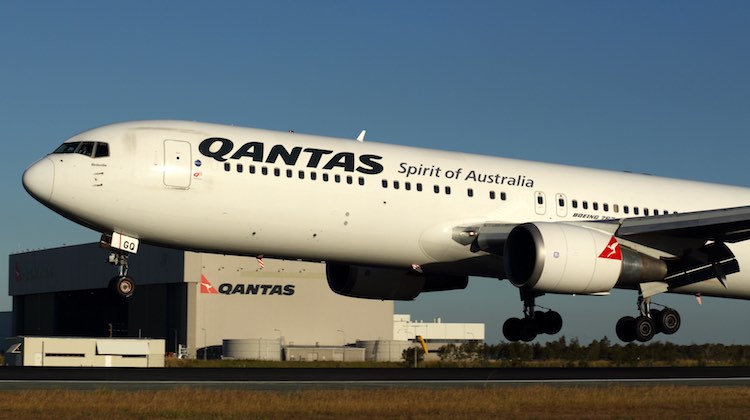Qantas to investigate foam alternatives after Brisbane hangar spill
April 21, 2017 by australianaviation.com.au
 File image of a (now-retired) Qantas 767 landing at Brisbane Airport with one of the airline’s maintenance hangars in the background. (Rob Finlayson)
File image of a (now-retired) Qantas 767 landing at Brisbane Airport with one of the airline’s maintenance hangars in the background. (Rob Finlayson) Qantas says it is investigating the use of alternative fire retardants after a foam spill at one of its Brisbane Airport maintenance hangars on Sunday evening.
The hangar’s sprinkler system released a reported 22,000 litres of PFOA fire retardant foam, some of which entered a nearby creek. The spill saw the Queensland Government issue a public warning to not eat seafood caught near the airport.
The Queensland Government banned the use of PFOA foam last year, but Brisbane Airport is covered by federal government regulations as it is on Commonwealth-owned land.
“While the foam we use in Brisbane meets our current requirements under federal safety regulations, we have been working through a process to replace it with a type that meets the Queensland Government’s updated requirements,” Qantas said in a statement on its website on Thursday evening.
“There are few fire retardant products available around the world that meet aviation standards for use in an aircraft hangar. We are working as quickly as possible to replace it,” Qantas said.
The federal government, meanwhile, says it is investigating transitional arrangements to firefighting foams that do not include PFAS substances such as PFOA and PFOS.
“While it is known PFAS can persist for a long time, there is no consistent evidence that PFAS exposure is harmful to human health,” Minister for Infrastructure Darren Chester said in a statement on Friday.
“The government is considering management options for PFOS and PFOA transitional removal from use, improved management and appropriate disposal of PFOS-containing firefighting foams at all facilities in Australia, consistent with the listing of the chemical under the Stockholm Convention on Persistent Organic Pollutants,” he said.
Queensland Environment Minister Steven Miles has called for the Commonwealth to ban the use of firefighting foams containing PFOA and PFOS.
“As we are not the regulator of Commonwealth-controlled sites such as Brisbane Airport, our ban doesn’t apply to Qantas,” Miles said in a statement on Thursday.
“As a result of the foam spill from a Qantas hangar at Brisbane Airport last week, Brisbane residents have been put at risk, which is a position that could have been prevented,” the Minister asserted.
“What I want to know is why one of the country’s largest and most reputable companies is still using firefighting foams containing PFOS and PFOA right here on our doorstep?”
Queensland introduced its PFOS and PFOA foam ban in July 2016 after they were linked to ground water contamination surrounding the Army Aviation Centre at Oakey, near Toowoomba, while in June 2016 the federal government announced it would spend $65 million remediating chemical contamination from firefighting foam at Oakey and RAAF Base Williamtown.
PFOS (perfluorooctane sulfonate) and PFOA (perfluorooctanoic acid) are per- and poly-fluoroalkyl substances (PFAS) that have been commonly used in firefighting foams. While media reports label PFAS as “toxic”, the federal government has said there is, at least as yet, no proven link between PFAS contamination and problems to human health.
“Whether PFOS or PFOA cause health problems in humans is currently unknown, but on current evidence from studies in animals the potential for adverse health effects cannot be excluded. Because the elimination of PFASs from the human body is slow there is a risk that continued exposure to PFOS and PFOA could cause adverse health effects,” a June 2016 federal government factsheet on PFASs notes.
Meanwhile, Qantas says it is investigating the cause of the foam spill.
“Together with the state and federal governments and Brisbane Airport, we’re acting to understand the impact of the spill and are not able to draw any conclusions until the investigation is complete,” the airline’s statement reads.
“We appreciate there are members of the community who are concerned, and we are responding as quickly as we can to determine the extent of any pollution and are committed to keeping all stakeholders updated through the process.”





